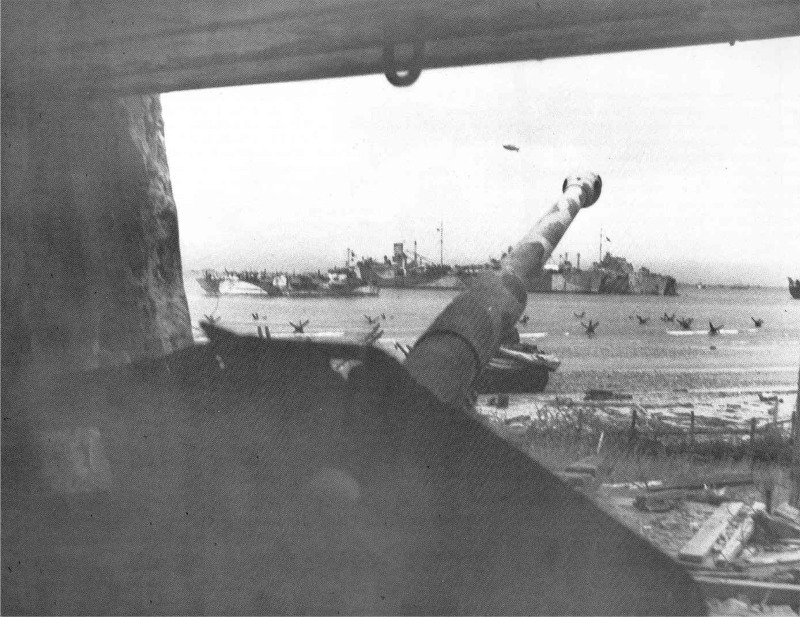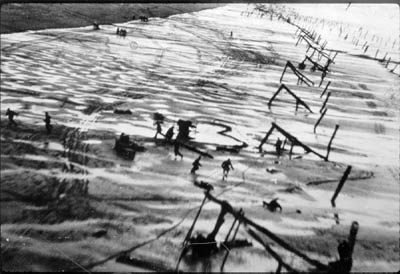

The Germans used millions of slave labourers during four years of occupation to construct the 'Atlantic Wall' - a modern fortification system along the coast of France. The fortifications consisted of a series of reinforced concrete gun emplacements supported by well protected infantry strong-points and heavy machine gun nests overlooking the beaches. These were surrounded by trenches with mortars and machine guns. The beaches were strewn with obstacles and mines. Tetrahedral obstacles - three iron bars intersecting at rights angles had been constructed on the beaches. Fields of barbed wire and mines covered the land past the beaches. Also the seafront houses provided excellent observation and firing positions for snipers. There were 32 static infantry Divisions of widely varying quality defending these fortifications along the French and Dutch coast.

View from German gun emplacement at Mike sector beach.
This first line of defence was backed up by Panzer Divisions (armoured
and motorized divisions) positioned inland from the Atlantic wall. The
strategy was, if the Atlantic wall were breached, theses elite formations
of crack mobile troops would strike as soon as possible after the landing
and throw the Canadians and the Allies back into the sea. Within striking
distance of the coast were five first-class divisions: the 21st Panzer
Division with an estimated 350 tanks, the 12th SS with 150 tanks, the
Panzer Lehr Division in the Le Mans area and two more tank divisions in
the Seine. The proximity of 12th SS and 21st Panzer Divisions made it
difficult for the British and Canadians to capture their objectives of
Caen on D-Day.
The coastal defences along Juno beach were defended by 3 battalions of the 716th Infantry Division with a strength of 7,771 soldiers all ranks. Although the division was made up of ordinary second rate troops, they proved to be strong defenders when concealed and protected by the coastal fortifications. The German plan was for the 716th Division to delay the Allied advance with artillery, mortars, mines and anti-tank guns until reinforcements from the 12th SS and 21st Panzer Divisions positioned near Caen could arrive.

Reconnaissance photo of Normandy beaches.
The 12th SS Division positioned 50 miles behind the coast had 20,540 men and a full establishment of 150 tanks. The 12th SS was a fanatical Hitler Youth formation raised to believe in the German master race and the Fuhrer. Two thirds of these soldiers were18 years of age and had received sophisticated battle training starting at the age of 16. They were a dangerous combination of patriotism, self righteousness and brutality. Colonel Kurt Meyer commanded three battalions of the 25th Panzer Grenadier Regiment. Meyer and the 12th SS would become the nemesis of the Canadian Army in Normandy.
On D-Day the 716th Infantry Division took the main weight of the Canadian assault and was virtually destroyed. By evening they had lost 80% of their artillery. The 21st Panzer Division was into action early on D-Day, unsuccessfully attacking the British Airborne to win back some of the bridges at Ranville-Benouvile. In the early afternoon the 192nd Panzer Regiment of the Division counterattacked the British on the west side of the Orne river. Parts of the regiment broke through to the coast but by 2100 hours had been stopped by the British. Having lost 25 % of its armour and no prospect of reinforcement, the regiment fought its way back to Caen.
At 1505 hours General Speidal ordered the 21st Panzer Division, 12th SS Division and Panzer Lehr to be grouped under 1st Panzer Corps for a coordinated attack at the Anglo-Canadian bridgehead. The plan to rapidly commit armoured divisions to prevent the Allies from consolidating their positions had assumed that the armour would be in position and coastal defences were capable of holding the allied advance. By this time however, the Canadians had decimated the German regiments defending the coastal positions and advanced miles inland. With the 21st engaged against the British and the reserve divisions arriving in pieces it became difficult to launch this coordinated counter attack.
The German Counterattacks
The 12th SS moved forward towards the front starting at dawn on D-Day but air attacks slowed their advance. The division's vanguard, the 25th Panzer Grenadier Regiment, commanded by Colonel Kurt Meyer moved into the area west of Caen. Meyer established his headquarters in the Ardennes Abbey on June 7 (D-Day + 1) and discovered the Canadian 9th Brigade advancing toward Carpiquet airport. The 25th Panzer Grenadiers attacked the exposed Canadian flank with two battalions supported by tanks. The Germans struck with great force and in vicious close quarter battles forced the Canadians out of Authie and Buron after heavy losses in tanks and men.
In defence, the Canadians infantry proved as stubbornly ferocious as the Germans, especially once they were able to bring their artillery to bear. In Normandy artillery was the most lethal weapon on both sides, causing three out of every four wounds. Supported by the big guns of a British cruiser, and the 12 remaining Sherbrooke Fusiliers tanks, the 9th Brigade fought their way back in forcing the Germans in turn to withdraw from Buron. The vanguard of the 9th Brigade was decimated. The North Nova Scotia casualties were 84 killed, 30 wounded and 128 captured. The Sherbrookes casualties were 26 killed and 34 wounded along with 28 tanks destroyed or damaged. The Germans had also paid, the Sherbrookes claiming to have destroyed up to 35 German tanks, thus reducing the effectiveness of the 25th Panzer Grenadier Regiment.
At dawn on June 8th the 26th Panzer Grenadier Regiment of the 12th SS attacked the Canadian 7th Brigade that had advanced up to the Caen-Bayeux road. The Germans attacked the town of Putot-en-Bessin with two battalions and surrounded the Winnipeg Rifles. The Canadian Scottish supported by the 1st Hussars moved back into the village under a creeping artillery barrage. After two hours of fierce fighting the Canadians recaptured Putot-en-Bessin and linked up with the remnants of the Winnipegs still holding on.
A third German battalion attacked Bretteville. The Regina Rifles stubbornly defended the town and the battle raged all night in the village streets. At dawn the next morning the 12th SS retreated after suffering heavy losses. To stop the German counter attack the Canadians paid a high price. The Winnipeg Rifles lost 256 men including 105 killed. The Canadian Scottish lost 125 men, including 45 killed while the Regina Rifles losses were smaller.
Many of the Winnipeg Rifles had been taken prisoner and were among the 45 Canadians executed by the 12th SS at the Abbey of Ardenne on June 8th. The previous day, 23 Canadian prisoners from the North Novas and Sherbrookes were shot by the men of the 12th SS. After the war Kurt Meyer would be held responsible for these war crimes and sentenced to death, a sentence later commuted to life imprisonment.
The German army had become experts in defensive techniques on the Russian
front. They were able to use the Normandy terrain to their advantage and
inflict heavy losses on the Allies when they advanced. However when the
Germans attempted offensive operations in Normandy they were faced with
the same difficulties. The Allies superior artillery brought overwhelming
firepower down on the Germans and decimated them. Starting with the 21st
Division counter attack on June 6th and in subsequent attacks, the Germans
suffered their heaviest losses when they left their defensive positions
and attacked the Allies.
